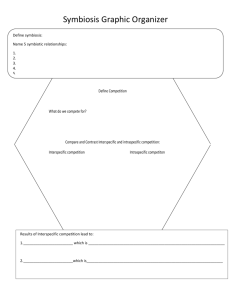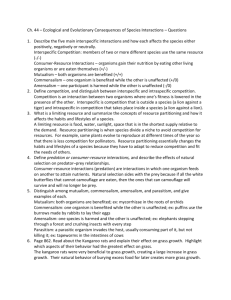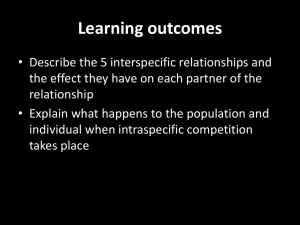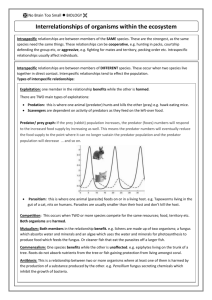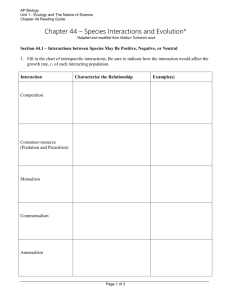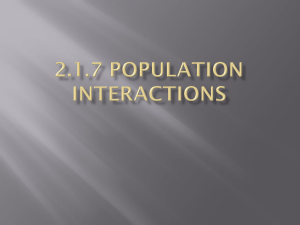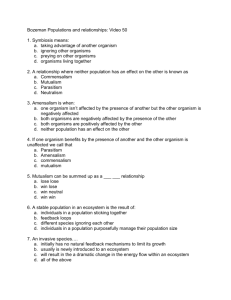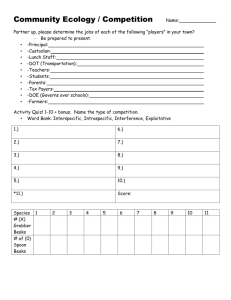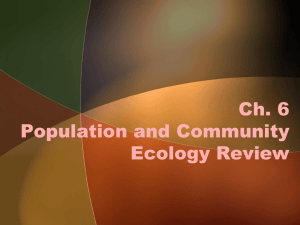File - Sarah Applebey
advertisement
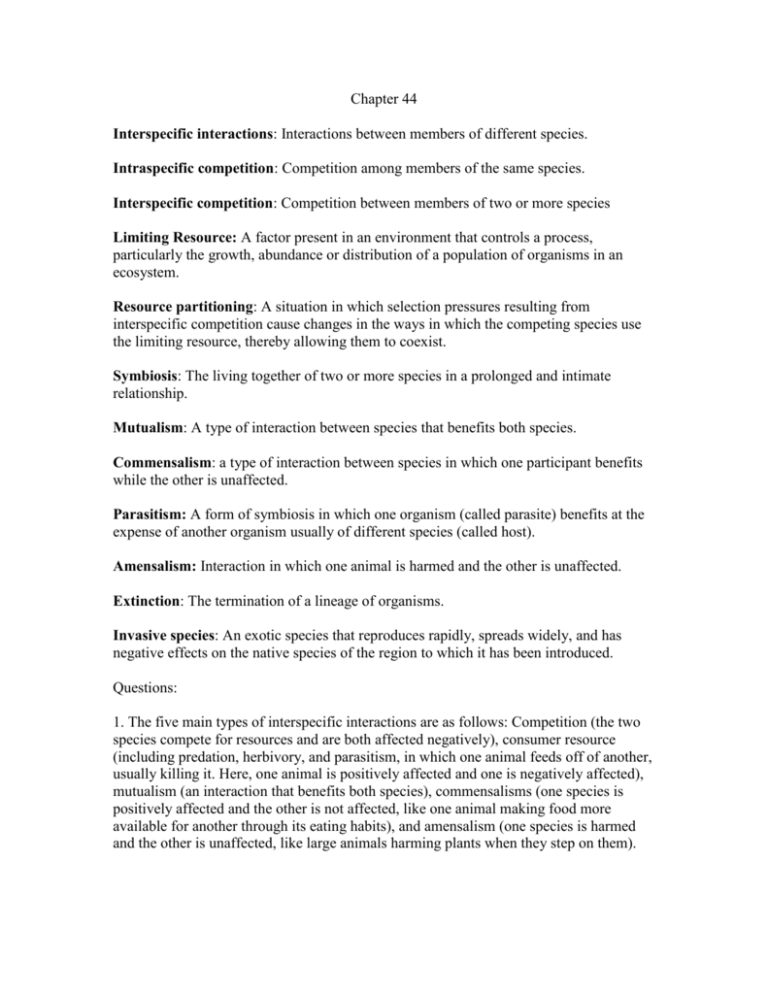
Chapter 44 Interspecific interactions: Interactions between members of different species. Intraspecific competition: Competition among members of the same species. Interspecific competition: Competition between members of two or more species Limiting Resource: A factor present in an environment that controls a process, particularly the growth, abundance or distribution of a population of organisms in an ecosystem. Resource partitioning: A situation in which selection pressures resulting from interspecific competition cause changes in the ways in which the competing species use the limiting resource, thereby allowing them to coexist. Symbiosis: The living together of two or more species in a prolonged and intimate relationship. Mutualism: A type of interaction between species that benefits both species. Commensalism: a type of interaction between species in which one participant benefits while the other is unaffected. Parasitism: A form of symbiosis in which one organism (called parasite) benefits at the expense of another organism usually of different species (called host). Amensalism: Interaction in which one animal is harmed and the other is unaffected. Extinction: The termination of a lineage of organisms. Invasive species: An exotic species that reproduces rapidly, spreads widely, and has negative effects on the native species of the region to which it has been introduced. Questions: 1. The five main types of interspecific interactions are as follows: Competition (the two species compete for resources and are both affected negatively), consumer resource (including predation, herbivory, and parasitism, in which one animal feeds off of another, usually killing it. Here, one animal is positively affected and one is negatively affected), mutualism (an interaction that benefits both species), commensalisms (one species is positively affected and the other is not affected, like one animal making food more available for another through its eating habits), and amensalism (one species is harmed and the other is unaffected, like large animals harming plants when they step on them). 2. Competition is the contest between organisms for resources, habitats, niches, etc. Interspecific competition is competition between members of two or more species and intraspecific competition is competition among members of the same species. 3. A limiting resource is a needed resource that prevents a species, community, or population from growing larger. For example, the amount of grass limits the amount of mice that survive if there is not enough to go around, therefore limiting the population. Resource partitioning depends upon the differences between species. It allows a species to live with another, for example, rock barnacles and stellate barnacles can live in the same area because one prefers to be lower in the water and another prefers to be higher. While resource partitioning allows a species to survive, it survives at a lower population than it would without the competing species. 4. Predation and consumer-resource interactions is a type of interspecific interaction in which one animal gains and the other is affected negatively. It takes place when an animals preys on another or when a herbivore consumes a plant. However, natural selection gives both species a fair chance. It gives the preyed upon species means to escape the predator, and the predator means to eat the prey. For example, if a zebra becomes faster to escape the lion, the lion also eventually becomes faster. It is an evolutionary arms race. 5. Mutualism is when both species benefit from the interaction, often in symbiotic relationships. For example, a bird picks the insects off a rhinoceros, gaining easy food, and the rhino doesn’t have insects living on its body. Commensalism is the interaction in which one species benefits and the other is unaffected. For example, the grazing of cattle forces insects into the open, making it easier for birds to find food. The cows are unaffected, but the birds benefit. Amensalism is the interaction in which one species is harmed and the other is unaffected. A tree, for instance, blocks out the sun for plants growing on the ground below, negatively affecting the plants but gaining nothing. Finally, parasitism is a consumer-resource interspecific interaction in which one species benefits and the other is harmed when the benefiting feeds off of it. For example, certain types of worms live inside the stomach of other animals, harming the animal’s digestive processes. 6. Kangaroo rats tend to have a positive affect on grass growth, unless there is a resource shortage. When there are not enough resources, the rats eat all the grass seeds. However, because rats bury the seeds, when there are enough resources, they do not eat all of the seed. Therefore, the seeds germinate into grass seedlings. 7. Both competition (contest within and outside different species for resources) and resource partitioning (dividing of resources among species) affects population distribution and density. For example, population density is lower due to resource partitioning because there are other species to share resources with, allowing the species to survive but not expand as much. Competition also limits population growth, because there are fewer resources to go around. It also affects population distribution because animals will move to where the environment can support them and where the competition for resources isn’t too high to handle. 8. Competition increases the fitness of a species because if there aren’t enough resources to go around, only the fittest animals find food and live long enough to reproduce and pass on the genes that kept them fit in the first place. It also leads to adaptation, because only the animals who can adjust to their surroundings and find food can survive. 9. Mimicry often helps animals disguise themselves and hid from predators. For example, if a plant has mimicked the appearance of butterfly eggs on its leaves, a real butterfly will not lay eggs on the plant, ensuring the plants fitness. 10. A species is invasive if it is unnatural to the areas, reproduces rapidly, and spreads widely. It usually has a negative affect on the native plants. For example, asian carp in lake Michigan are taking in resources normally allotted to native species.
